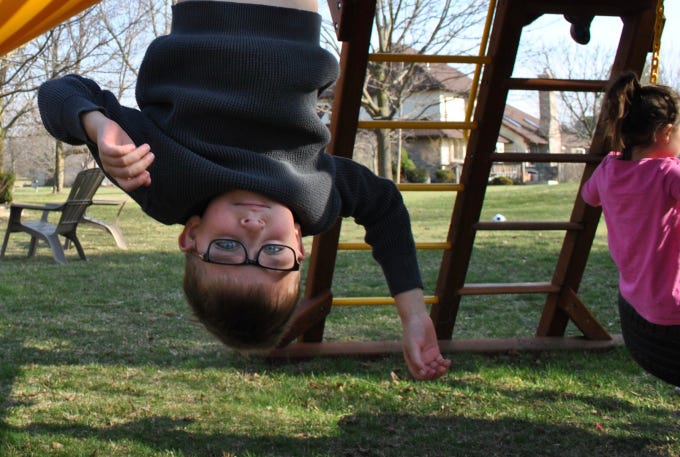Begin by hanging in a moderate position for about 30 seconds to 1 minute initially. Gradually increase the time in 2 to 3-minute intervals. Always pay attention to your body’s signals. If you start feeling unwell, return to an upright position. Over time, you might be able to use an inversion table for around 10 to 20 minutes.
However, Hanging upside down, whether through inversion therapy or other activities, has captured human curiosity for its potential benefits and risks.
Here you will get to know more details about it.
What are the Benefits of upside down?
Inversion therapy endeavors to counteract the compressive forces of gravity on the spine often carried out through the use of specialized inversion tables. These tables feature ankle holders and adjustable positions that enable various degrees of backward tilting, including full inversion where the body is completely upside down.
In practice, this approach aims to elongate the spine, alleviating pressure on intervertebral discs and nerve roots. Additionally, it is believed to contribute to an augmentation in the intervertebral space. The potential advantages associated with inverted positions during this therapy encompass:
- Provision of short-term relief from conditions like back pain, sciatica, and scoliosis.
- Enhancement of spinal well-being.
- Facilitation of improved flexibility.
- Potential reduction in the necessity for back surgery.
However, it’s imperative to acknowledge that the substantiation for these perceived benefits remains limited. Robust empirical support for the effectiveness of inversion therapy remains elusive, with most existing studies having been conducted on a relatively small scale.
In addition, Comparable to alternative therapies such as acupuncture or cupping, the outcomes of inversion therapy are inherently variable, contingent upon individual responses. It’s worth noting that comprehensive research efforts are still lacking to definitively validate the merits of hanging upside down as a therapeutic approach.
As such, while inversion therapy may hold potential, a more comprehensive body of research is imperative to discern its actual efficacy and applicability across a diverse range of individuals.
What are the potential effects and risks?

- Increased Blood Pressure: When the body is inverted, blood can pool in the upper regions, potentially leading to increased blood pressure. This elevation in blood pressure may not be suitable for individuals with hypertension or other cardiovascular conditions.
- Head Discomfort: Being upside down can lead to discomfort, pressure, or even headaches due to the rush of blood to the head.
- Dizziness and Nausea: Hanging upside down for extended periods can cause dizziness, lightheadedness, and nausea, particularly for those not accustomed to such positions.
- Increased Intraocular Pressure: Inverted positions may elevate pressure within the eyes, which can be problematic for individuals with certain eye conditions.
- Risk of Falling: Inversion activities can carry a risk of falling, especially if not properly supervised or if equipment is not used correctly.
- Joint and Muscle Strain: Prolonged inversion can place strain on joints and muscles, particularly in the neck, back, and shoulders.
- Spinal Issues: Individuals with certain spinal conditions, such as herniated discs, might experience exacerbation of symptoms or additional stress on the spine.
- Increased Intra-abdominal Pressure: Inversion can lead to an increase in intra-abdominal pressure, potentially impacting individuals with certain gastrointestinal conditions.
- Risk of Asphyxiation: Staying upside down for an extended duration can lead to the accumulation of blood in the upper body, potentially impacting breathing and causing discomfort.
- Individual Variability: People respond differently to inversion, and what works well for one person may not be suitable for another.
Tips on Upside Down Without Getting Death
Caution with Prolonged Inversion: Hanging upside down for long periods could be dangerous, especially for individuals with health issues. While healthy individuals might tolerate it, those with illnesses might face risks. It’s crucial to avoid prolonged inversion without professional guidance.
Consult a Licensed Therapist: If you’re interested in reaping the benefits of inversion therapy, it’s advisable to consult a licensed therapist. They can guide you on proper techniques and help determine if this therapy is suitable for your individual health profile. Remember, inversion therapy may not be suitable for everyone.
Moderation for Benefits: Hanging upside down for a few minutes can offer potential benefits, as claimed by yogis and individuals undergoing inversion therapy.
Certified yogis, physical therapists, and experts should guide these practices. Scientific studies have supported some of these claims.
Prioritize Your Well-Being: Listen to your body at all times. If you start feeling unwell before or during inversion, it’s essential to stop immediately. Your health and comfort come first.
Expert Supervision: Engage in inversion activities under the guidance of an expert. Whether it’s a certified yoga teacher, physical therapist, or medical doctor, their presence ensures your safety and prevents potential harm.
Why Would A Human Hang Upside Down For That Long?

There are several reasons for exceeding time limits in headstands, with notable ones including:
- Competitions: Surprisingly, competitions exist for the longest headstand, pushing participants to train rigorously and endure extended periods of inversion.
- World Records: The Guinness Book of World Records recognizes such feats, with daredevil David Blaine setting a record of 60-70 hours of continuous head standing in 2008, though at the cost of his health.
- Testing Limits: Some seek to explore their physical boundaries, attempting headstands without understanding the potential consequences, even venturing into challenging environments like closed caves.
- Friendly Challenges: Innocent bets or challenges can turn dangerous when friends wager on each other’s endurance, often disregarding health for the sake of the game.
How Long Can A Human Hang Upside Down as a Yogis?
| Health Conditions | Duration |
| Perfectly Healthy | 72 hours |
| Partially Fit | 45 hours |
| Average Health | 28 hours |
Furthermore, The duration one can stay in an upside-down position varies based on their overall health and physique. This variance is influenced by metabolism. During a headstand, blood pressure decreases, and more blood flows to the head, which can have benefits like promoting hair growth and aiding back pain relief.
However, there’s a carefully determined time limit to avoid potential issues.
While experienced yogis can manage extended durations, the average person requires practice. Staying inverted also changes one’s perspective and can lead to ill effects if maintained for too long.
In the end, Stroke and swelling of brain membranes are potential risks due to increased pressure. Dehydration and blood clotting are also concerns, given the body’s altered gravitational pull during inversion.
FAQs
Can your body adapt to being upside down?
Yes, your body can gradually adapt to hanging upside down. Typically, within about 60 seconds of inversion, you start experiencing the relaxing advantages.
What happens if you’re hung upside down for 24 hours?
it’s extremely dangerous to hang upside down for 24 hours. Blood pooling in the head can strain the heart, risking a cerebral stroke and even death.
Does blood rush to your head when you’re upside down?
Yes, when hanging upside down, gravity causes blood to rush to the head, resulting in dizziness. About 2 gallons of blood in the body are affected by this gravitational shift.
Does hanging upside down improve skin health?
Yes, inversions can boost blood circulation, potentially aiding skin issues like acne and wrinkles by counteracting the effects of gravity. This can lead to healthier, more radiant skin.
Does being upside down cause pain?
Yes, inversion therapy might not provide lasting relief from gravity’s effects, and it can lead to unpleasant side effects such as headaches or retinal bleeding.
Is allowing blood to flow to the head beneficial?
Yes, maintaining healthy blood flow to the brain is crucial for optimal brain function. The brain requires nearly 20% of the blood supplied by each heartbeat to function properly.
Conclusion:
To sum up, the practice of hanging upside down offers potential benefits and poses inherent risks. On the other hand, gradually adapting to inversion over about 60 seconds can lead to relaxation.
Also, caution is crucial, as hanging upside down for extended periods, such as 24 hours, can strain the body, elevate blood pressure, and even risk cerebral stroke. While blood rushing to the head has both advantages and disadvantages, the potential benefits of inversion therapy, like spinal relief and improved skin health, are still being explored.
In summary, the duration and method of hanging upside down should be approached thoughtfully to maximize its potential advantages while minimizing associated risks.












